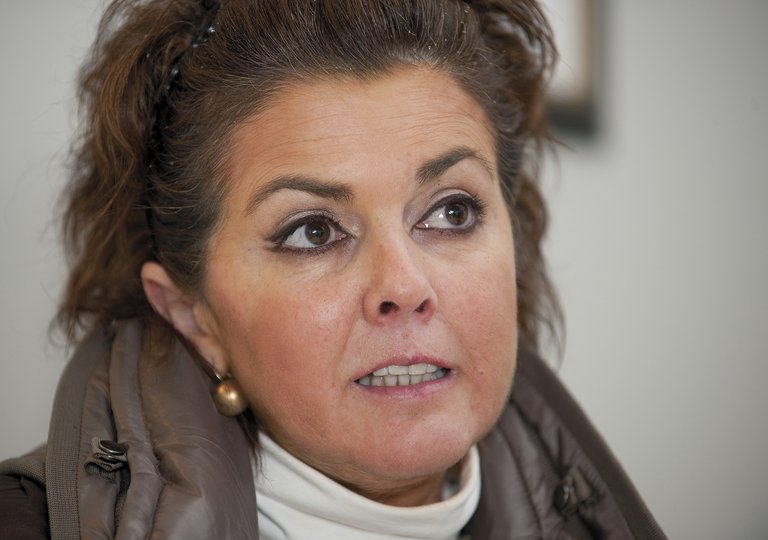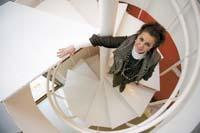"The behaviour of animals has consequences not only on their well-being but also on their production and product quality"

Newcastle disease is common in poultry farms. When an animal is stressed, it is more sensitive to viruses and bacteria and has less ability to fight the disease. In addition, in these farms there are a large number of animals in a small place, so the virus spreads easily from one animal to another. The best example of comparison that occurs to me is that of schools, when the virus is transmitted from one child to another. Something similar happens in animal production facilities. This is the case of avian influenza.
These pathogenic diseases can only be controlled by vaccines. However, by developing new techniques and designing facilities, we can help the animal resist, relax and defend itself against diseases. If we get the animal not very stressed, this animal will have more ability to adapt to the environment and defend itself from attacks of viruses and bacteria. The problem is that in poultry farms there are thousands of animals and it is almost impossible not to infect them. However, proper animal management can significantly reduce the problem.
Domestic animals in general, and chickens and chickens in particular, have very complex social behavior. We are not aware of it until we start working with them, but the truth is that they are able to do and learn many things, surprisingly. For example, with the sound of starting feed delivery hoppers, birds know they will have immediate access to food and come to eat.
In several experiments conducted in Australia to analyze the behavior of these birds, it has been observed that the chickens emit certain sounds to warn of the proximity of the predator. In addition, these sounds are different depending on whether the predator is terrestrial or aerial. As for fecundity, they also have very worked behaviors. For example, females tend to equate to the dominant male. However, an English researcher has found that after matching the female with a male, he has the possibility to pair it with another male more dominant than this one, eliminating the sperm of the previous one.
In reality, their social behavior is extremely complex. Any alteration of this social system can lead to different behavior from animals, which can generate extreme stress. As a result, animals are more sensitive to diseases and these high-stress situations can depress the immune system. In addition, all this can reduce the fertility of these animals. All of them are applicable to all pets. It is therefore important to take into account the behaviour and welfare of animals in production plants.

It is essential to provide animals with the necessary space so that they can correctly develop their daily activity. For example, if they don't have enough space to walk or do some sport, chickens may have leg problems. Also, laying hens can develop osteoporosis. The amount of eggs they produce is huge -- one egg per day. The eggshell is made up of calcium, and although chickens ingest a lot of calcium in their diets, it can end up with osteoporosis. That's why it's important to do some sport to take care of bone health.
Animals are not organized or distributed randomly, but have places to do some activities. For example, they tend to be located in areas that feel protected, near walls or under certain objects, as if they were under the roof.
As chickens, although they have a lot of space in the center of the pavilion, tend to concentrate on the edges. This behavior can cause production problems, as it increases the likelihood of involuntary violations. This causes, among other things, the depreciation of meat, as happens with an apple that has suffered blows. Therefore, the behavior of animals has a series of consequences not only on their well-being, but also on their production and on the quality of the product, in this case of meat. This form of distribution can increase the state of stress of animals and if the animal is stressed it is detected by moving it to the slaughterhouse, since the meat is lighter or pale and loses much water. Consequently, the consumer does not appreciate this meat so much. I have worked for many years on this subject, that is, towards a homogeneous use of space.
Yes. According to our studies, we have found that with the use of mobile walls, cheap and easy to use, the spatial distribution of birds can vary considerably, thus achieving improvements. We managed to patent in the United States. Without these panels only 5% of birds were located in the center of the pavilion, but with these panels it has been proven that this proportion can reach 25%.
With the birds destined for production we conducted a series of experiments using this same system in five commercial pavilions. We observed that the fertility rate and egg production increased, exceeding by more than 3% the production of groups of birds investigated.

This technique is also interesting for an animal that has entered a fight. If animals do not have shelter, the confrontation can last a long time. Through these panels or other shelters, the attacked animal can escape. It is a way to reduce aggression or conflict. With these panels we managed to reduce the attacks by 50% in the experiments carried out.
Among others, we have analyzed meat chickens. These chickens grow very fast thanks to genetic selection and not the use of hormones. Actually, hormones have never been used in birds, although this bad suspicion is widespread among consumers. The problem is that growing so fast (around 42 days) they have weaknesses and mobility problems in the legs. Sports help to harden and muscle the legs. Therefore, we have designed strategies to increase the sports level of these animals. In some experiments we used hangers and some obstacles to settle between food and water. Chickens eat first and drink later. They always have the same behavior, one after the other. Therefore, after eating they should surround or jump those obstacles if they wanted to drink water. We found that animals that had to adapt to this situation had fewer leg problems.
All the poultry farms in the Basque Country that I have seen since I have returned from the United States have surprised me: they are very careful about cleaning, animal care, etc. In addition, for me it is very enriching and interesting to work with the producers of birds of the Basque Country, who have a very specific vision of the production of birds, very linked to the Basque geography. Great importance is attached to product quality and local production. I hope to help you with my experience in bird production in different countries (Sweden, France, Canada), especially with the US experience. In addition, in recent years, the pressure of European legislation on animal welfare is constantly increasing, so my research could contribute to this sector.
Buletina
Bidali zure helbide elektronikoa eta jaso asteroko buletina zure sarrera-ontzian











